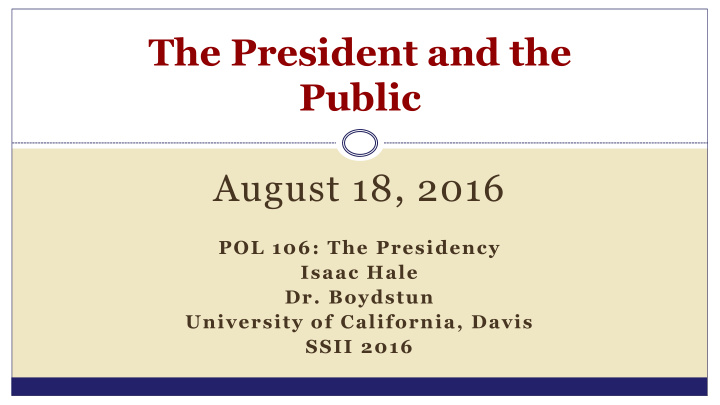



The President and the Public August 18, 2016 POL 106: The Presidency Isaac Hale Dr. Boydstun University of California, Davis SSII 2016
Outline Baum: “Talking the Vote: Why I. Presidential Candidates Hit the Talk Show Circuit.” (2005) Canes- Wrone and Shotts: “The II. Conditional Nature of Presidential Responsiveness to Public Opinion.” (2004) Cohen: “If the News is So Bad, Why Are III. the Presidential Polls So High?” (2004) Slide 2 of 22
Baum: “Talking The Vote” What question is Baum seeking to address? Why talk shows? What is the significance? What are the data? Slide 3 of 22
Baum: “Talking The Vote” What are Baum’s hypotheses? Relative to traditional media, interviews on E- talk shows will… H1: be less partisan H2: be more favorable towards the subject H3: have less emphasis on substantive issues Slide 4 of 22
Baum: “Talking The Vote” Define Baum’s terms: Political awareness Likeability ratio What are Baum’s findings… Slide 5 of 22
Baum: “Talking The Vote” Slide 6 of 22
Baum: “Talking The Vote” Do you buy Baum’s model? Why or why not? How might you critique Baum’s research design? If you were to replicate this design today, would you do it any differently? Can we connect this article to Vavreck and Erikson? Slide 7 of 22
Canes-Wrone & Shotts What question are the authors seeking to address? What is the significance? What are the data? What’s the timespan? Slide 8 of 22
Canes-Wrone & Shotts Define the authors’ key terms: Policy Congruence Popularity President’s ideological congruence The data…. Slide 9 of 22
Canes-Wrone & Shotts Slide 10 of 22
Canes-Wrone & Shotts The authors have three hypotheses… Slide 11 of 22
Canes-Wrone & Shotts Slide 12 of 22
Canes-Wrone & Shotts Slide 13 of 22
Canes-Wrone & Shotts Slide 14 of 22
Canes-Wrone & Shotts What are the authors’ findings? Is this good news or bad for American democracy? What do they find regarding second-term presidents? Critiques and comments? Slide 15 of 22
Cohen: Bad News, High Polls What is Cohen’s research puzzle? What is his theory? What is the significance? What are the data? Slide 16 of 22
Cohen: Bad News, High Polls Slide 17 of 22
Cohen: Bad News, High Polls Slide 18 of 22
Cohen: Bad News, High Polls What are his findings? Media has decentralized and become more competitive Reporting is more negative overall The public consumes less news from traditional outlets Public trust in news media has declined Slide 19 of 22
Cohen: Bad News, High Polls Slide 20 of 22
Cohen: Bad News, High Polls What are the implications? Is the current news environment an unqualified plus for presidents? How has “going public” changed? Why? Comments? Critiques? Slide 21 of 22
For Next Time… Cohen: “From the Fabulous Baker Boys to the Master of Disaster: The White House Chief of Staff in the Reagan and G. H. W. Bush Administrations.” (2002) Pfiffner: “The Contemporary Presidency: Decision Making in the Bush White House.” (2009) Pfiffner: “Decision Making in the Obama White House.” (2011) Come ready to compare/contrast the Pfiffner articles! Slide 22 of 22
Recommend
More recommend